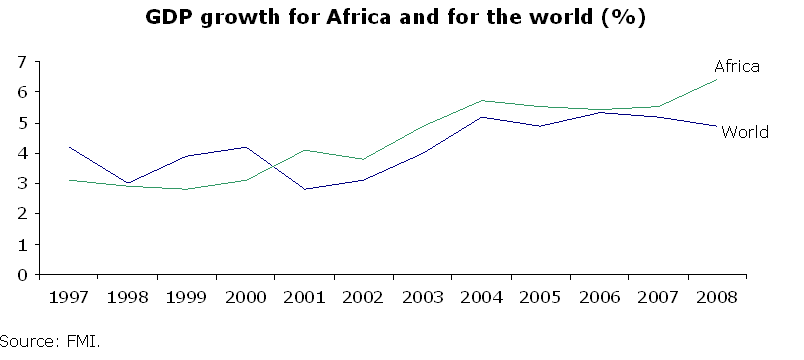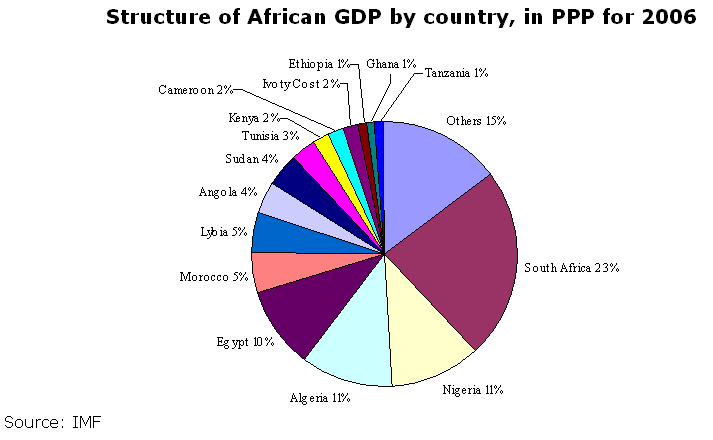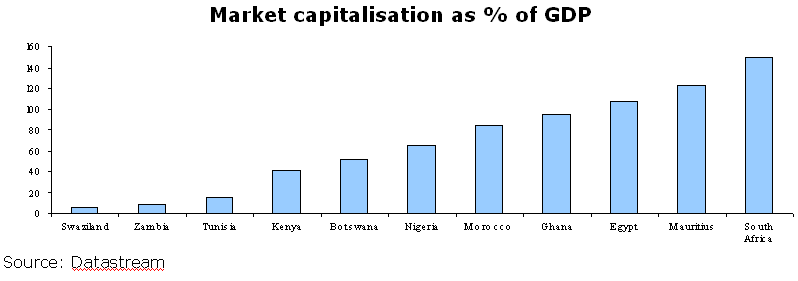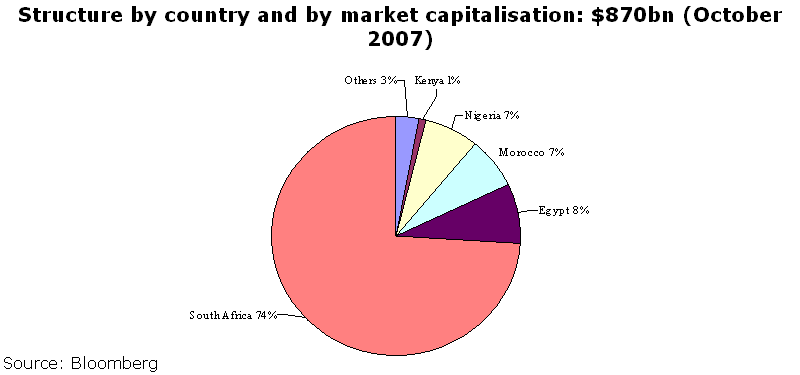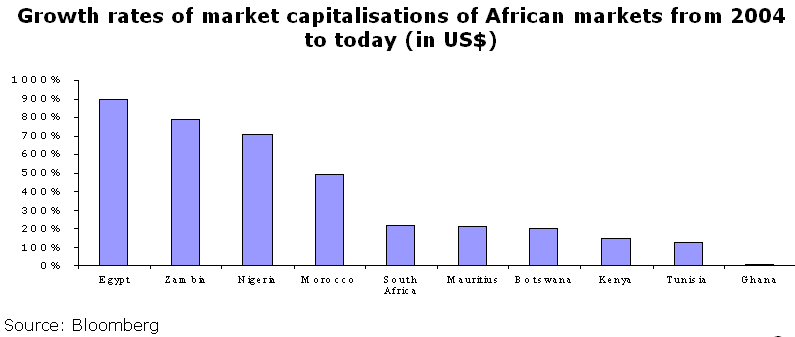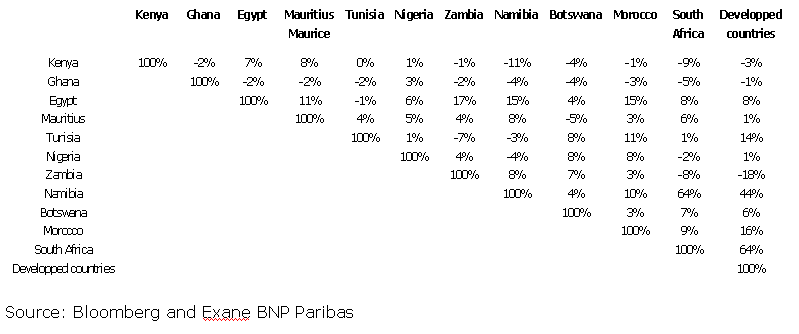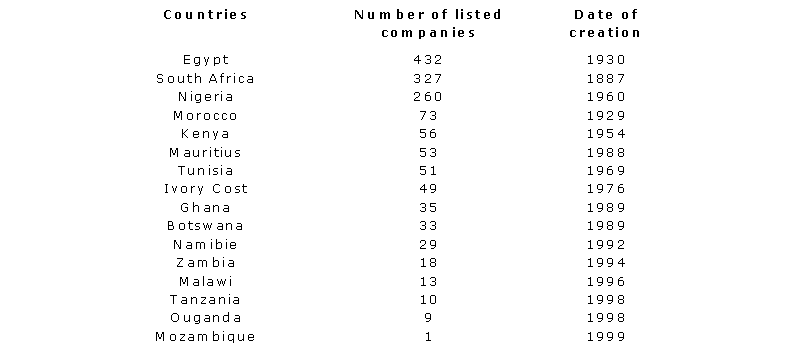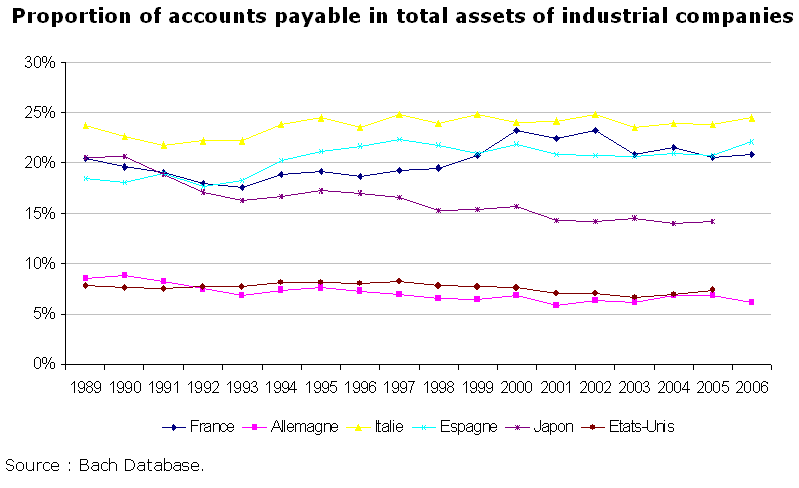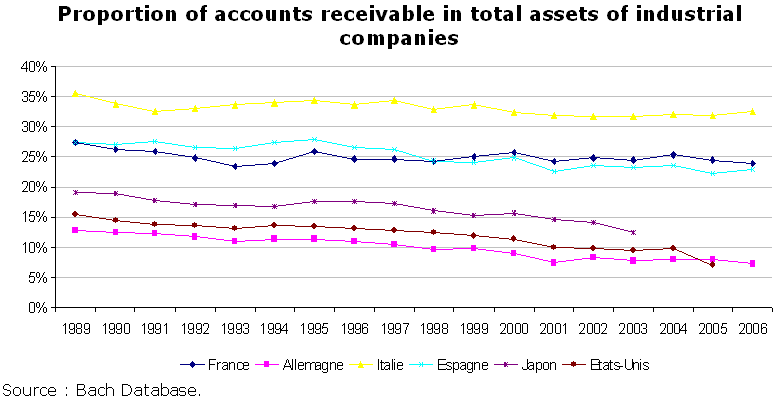Letter number 31 of April 2008
ALL ARTICLES
- TOPIC
- STATISTICS
- RESEARCH
- QUESTIONS & COMMENTS
News : Finance in Africa
A marked improvement in the economic situation
No matter what economic indicator you take, it is clear that for several years now, the economies of African countries have been improving. Africa is in fact the only geographic region for which the IMF is forecasting higher growth in 2008 than in 2007. And that’s not all – since 2000, the growth rate for Africa has exceeded the world growth rate:
At the same time, inflation has fallen sharply: from 30% in the mid 1990s to 6.6% in 2007 and 6 % in 2008 according to the IMF (excluding the woebegone Zimbabwe) :
For the first time since 1990, only four African countries will record annual inflation of more than 10% in 2008.
Current balances across the continent are generally back in the black. It is true of course that rising oil prices have given a boost to the economies of oil exporting countries, but many African countries without any oil reserves no longer have very large deficits either.
The continent’s foreign debt fell from 60% of GDP in 1990 to less than 30%, helped by a budget deficit that went from -2% to -11% in the early 1990s, to -2% to +4% in 2006, and by exports whose value exceeded imports by 20%, largely driven by the very sharp rise in commodities prices.
Finally, exchange reserves rose from around 20bn SDR to 150bn SDR in 2006.
Whether the consequence or cause of economic improvements, the number of countries experiencing political upheaval has been falling constantly since the 1990s, when only 12% of African countries were democracies, compared with 60% today.
This said, and notwithstanding the overall improvement, most African countries remain firmly at the bottom of the UN’s human development rankings, with 30 countries between 140 and 177.
Despite the advances it has made, Africa is still under-represented on the world economic stage. The continent accounts for 11.5% of the planet’s population but only 3.5% of world GDP (measured in purchasing power parity).
At the same time, disparities between African countries are high, with the top four countries generating over half of the continent's GDP and the top nine accounting for over three-quarters:
Economically, Africa can be split into three zones:
• North Africa: 41% of GDP and 17% of the population
• Black Africa: 31% of GDP and 78% of the population
• and finally, South Africa: 28% of GDP and 5% of the population
South Africa’s share of GDP has gradually been diluted by the steady improvement of the economy in North Africa and by the rebound in business in Black Africa since 2000.
Stock markets in full development
There are seven countries in Africa which have fully functioning stock exchanges – South Africa, Nigeria, Egypt, Morocco, Kenya, Tunisia and Mauritius:
However, South African companies account for 74% of Africa’s market capitalisation:
These markets have been experiencing very strong growth since 2004.
These markets theoretically provide investors with very wide diversification as there is little correlation among the markets themselves and they are not correlated to the world’s equity markets.
Nevertheless, and unsurprisingly, the case of South Africa shows that when a market grows in size, it loses its capacity to diversify and increases its correlation with other markets:
…given the small size of these markets:
…the contribution made by diversification, without sending share prices rocketing, is small.
The main listed companies are telecoms groups (Télécom Maroc, Orascom Télécom, …), banks (Attjari Wafa Bank, Banque de Tunisie, National Bank of Malawi, …), mining groups (Anglogold Ashanti, Anglo American, Iam Gold, …) which often enjoy dual listing in London or in Australia, food groups (SAB Miller, East African Breweries, Zambia Sugar, …) and local subsidiaries of multinational groups (Lafarge, Barclays, Standard Chartered, Diageo, ...).
Stock exchanges are a visible part of African finance, but only account for a very limited section of the economy.
At the other extreme is microfinance (1).
An underdeveloped banking system
Falling between the more sophisticated systems in place in North Africa and South Africa, we have the still underdeveloped banking system of Black Africa. According to the IMF, loans granted to the private sector in 2006 accounted for 16% of GDP in West Africa (UEMOA) and 6% of GDP in Central Africa (CEMAC) compared with 84% in South Africa (107% in developed countries).
The situation is a lot different in North Africa, where some countries have well-developed banking systems (Morocco, Egypt) and in South Africa.
In the franc zone, two thirds of loans are granted for periods of less than 12 months. In Uganda, only 0.5% of fixed term deposits are on deposit for longer than 12 months. The average maturity period of debts in sub-Saharan countries is 231 days, compared with 5.5 years in developed countries. At the same time, banks have excess liquidity, with deposits in 2006 accounting for 111% of loans to the private sector in West Africa and 171% in Central Africa, and this notwithstanding the fact that only 5% of the population in this region has a bank account.
According to the World Bank, this means that 42% of companies in Black Africa employing fewer than 25 people do not have access to bank loans, and they 28% of companies employing between 26 and 100 employees are in the same situation.
These companies are victims of poorly defined property rights (putting up collateral involves a complicated and lengthy process), a complex accounting system which encourages companies to stick to the informal lending sector, a shortage of competent and credible accounting firms, and the complete lack of central credit surveillance bodies. Additionally, information asymmetry encourages restricted, forced self-financing.
* * *
If René Dumont were to publish his best-selling “False Start in Africa” (1966) today, he would probably be more inclined to title it "The New Dawn of Africa".
There is much encouragement to be drawn from the progress made by the continent and the interest it is attracting (the Russian financial group Renaissance has just raised a $500m fund to invest in Africa, the Chinese bank ICBC has just invested $5.5bn in South Africa’s Standard Bank), even though the road to development is likely to be very long and at times rather rocky.
(1) For more details see the Vernimmen Newsletter n° 22, January 2007.
Statistics : Working capital around the world
Globalisation is also at work with working capital around the world.
Since the beginning of the nineties there has been a clear convergence towards a gap between receivables and payables or around 4% of total assets for industrial companies has shown by the latest available statistics:
Research : Actual share purchases timing and liquiditiy
This month we take a look at the results of a study on share repurchases by two French researchers. Given the lack of available data, very few empirical studies have done in this area. Ginglinger and Hamon (1) were given access to a data base of share repurchases made by French listed companies between 2000 and 2002. Their conclusions shed light on the motivations behind and consequences of share repurchases.
There are two opposing theories as to why managers of firms carry out share repurchases. According to the market timing theory, managers repurchase shares in their own firms when either the share or the firm is undervalured. They have access to information that enables them to identify any undervaluation and to use this knowledge to repurchase shares at a low price. On the other hand, the price support theory explains that a share repurchase is intended to prop up the share when prices are falling. This theory is quite different from the first. The share is not necessarily undervalued and the share repurchase is not the result of the exploitation of information asymmetry (2).
The study shows that the value of shares is much lower on the day of the repurchase than in the preceding months (by close to 3%). This is compatible with the two theories. The drop in price could justify a repurchase, either to take advantage of the undervaluation or to prop up the share. However, the rest of the study is more supportive of the second than the first theory. The return over the five days following the repurchase is no different from that of shares that have not been repurchased. In other words, firms that repurchase their own shares do not benefit from information asymmetry. Accordingly, the authors of the study prefer to back the second theory – the purpose of a share repurchase is to stabilise market value in the event of a downward trend.
The other important result of the study shows the impact of share repurchases on the liquidity of the shares in question. Two contradictory effects are expected. On the one hand, the act of repurchasing shares itself results in an increase in the number of orders on the order book which reduces the bid-ask spread. But on the other hand, information asymmetry (in the case of market timing) like inconsistent behaviour (in the case of price support) always leads to an increase in the bid-ask spread and a reduction in liquidity.
Share repurchases result in a reduction in liquidity, with the average spread rising from 2.33% before the repurchase, to 2.4% after, which is statistically significant.
4.The features of the loan itself statistically provide less explanation for the existence of collateral than the factors mentioned above. Efforts made by the bank to select loan candidates (which Voodeckers and Steijvers measure by their response time) do not reduce the probability of collateral being required. This contradicts the notion that banks use collateral as a substitute for credit analysis.
The results arrived at should be taken with caution, given the specificity of the sample (a single bank, on a very specific market and over a relatively short period). The study does, however, have the merit of validating certain theoretical observations and invalidating others, on an issue for which empirical analyses are still infrequent.
Another argument put forward by Dittmar and Thakor in support of their theory is that firms’ investment expenses increase much more frequently after a capital increase than after they take on new debt. This ties in with the idea of issuing equity to finance projects, which could not be predicted under the timing hypothesis.
In conclusion, Dittmar and Thakor have come up with a new explanation for the motivations behind equity issues. The theoretical model put forward, given its many very strong assumptions (absolutely no conflict of interest between management and shareholders, investors are fully informed and rational), may not necessarily convince everyone, but the empirical study opens up new paths and demonstrates that this topic could still be the subject of a number of studies that, hopefully, will lead to new discoveries.
(1) E.Ginglinger and J.Hamon, 2007, Actual Share Repurchase, Timing and Liquidity, Journal of Banking and Finance, 31 (3), p.915-938
(2) For more information, see chapter 38 of the Vernimmen.
Q&A : The MIFID directive
The MiFID is a European directive that came into force on November 1, 2007 in all of the countries in the European Economic Area (1) and covers the markets in financial instruments, hence its name.
It arose out of a very clear political will to increase competition on financial markets in order to reduce trading costs. Stock exchanges often enjoy a de facto or de juris monopoly (rule that orders must be concentrated), which is not the best guarantee that the prices of services provided will be as low as possible, given that competition is non-existent or very weak.
The MiFID does away with the obligation to execute orders on a regulated market such as Euronext, and sets up, alongside the regulated markets, two alternative ways of executing orders:
• multi-lateral trading systems (Multilateral Trading Facility or MTF, Alternative Trading System or ATS, Electronic Communication Network or ECN) such as Chi-X, Turquoise;
• systematic internalisers, ie, investment service providers (ISPs such as banks, foreign exchanges, etc.) which execute orders received from their clients against their own books or against orders from other clients, in an organised, frequent and systematic manner, on the basis of prices displayed for the shares considered as liquid and for orders below or equal to a set amount, and on the basis of prices disclosed upon request for others.
There are two risks of introducing competition in the execution of orders:
• spreading the volumes traded among stock exchanges expands the gap between the ask price and the call price (2). This risk could be attenuated by the development of trading volumes and the introduction of more competition;
• trading would become more complicated for ordinary dabblers in shares who, faced with a choice of where to execute orders, may not always be sure of where to get the best price at the time of the trade.
To remedy this, the ISP has a best execution obligation, requiring it to execute its client’s order on the market offering the best conditions for its client at that precise moment.
This best execution rule only applies to retail clients (private investors and small firms) and to professional clients (banks, insurance companies, UCITS, management firms, governments, central banks and companies meeting at least two of the following criteria: sales exceeding €40m, total on balance sheet more than €20m, equity capital of more than €2m). It does not apply to a third category of client, known as Eligible Counterparties (ISPs, banks, insurance companies and UCITS). Classification is based on questionnaires filled in by clients. Anyone trading in shares in the EEA would have filled them in at the end of last year.
Thank heavens (or rather thank the European lawmakers), this classification is not rigid. So, retail investors could be classified as professional clients if they meet two of the following three criteria: have completed 10 trades a year, have a portfolio whose value exceeds €0.5m or have held a position in the financial sector.
They will not enjoy as much legal protection but they will be able to access more complex products. ISPs are required to ensure, before offering a financial product to their clients, that the client has a good understanding of the product and that it is compatible with the clients’ financial situation and objectives.
The directive also makes provision for pre-trade transparency relating to the display of prices at the time of the trade and for post-trade transparency. Regulated markets, MTFs and Systematic Internalisers are required to disclose the nature of the trades to the stock market regulator.
(1) EU member states plus Iceland, Norway and Liechtenstein.
(2) In a recent research article, Thierry Foucauld and Albert Menkveld have demonstrated that this is not the case, see Competitions for order flow and smart underouting systems. Journal of Finance, 63(1), 119 – 158, February 2008.
